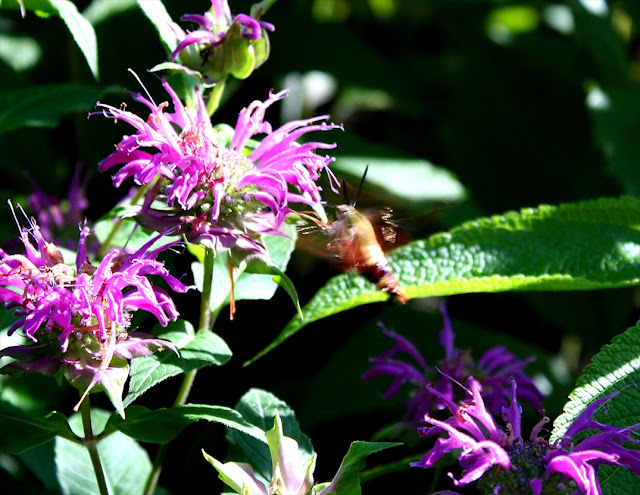Monarda 'Blaustrumpf' and 'Clair Grace' don't shout for attention, even in the entrance garden, but their nectar brings a frenzied whirl of bees and wasps, and, in great numbers, these Hummingbird moths.
This is a North American genus, Hemaris thysbe. Wikipedia says it is not to be confused with a similar Hummingbird moth prevalent throughout Europe and across Asia to Japan, which is an entirely different genus, Macroglossum stellatarum.
In fact, a local New Jersey web page tells me these photos are not of Hemaris thysbe, but a variant named Hemaris gracilis.
I suppose the point is that my garden seems to be quite wildlife friendly.
The main garden in the back is a haven for the Praying mantis and many other insects. Strangely no mosquitoes, probably because our thousands of frogs (I do not jest) prevent them.
Twice recently I've found the skeletons of small animals--a fox and a rabbit, I think--so there must be predators too. Interesting to speculate what they might be.
Two weeks ago a great black bear was at the front door!




You didn't get a photo of the black bear did you James? One of the quiet joys of gardening to me is discovering /encouraging wildlife. It makes me feel the garden has positive purposes beyond the visual and human and that I'm part of a much bigger network. I like it that the garden's not about (just) me.
ReplyDeleteWe have hawkmoths, I like to call them flying crayfish. Nothing else has a tail like that!
ReplyDeleteThose are nice shots James.
ReplyDeleteI've got the Hawk moth you mentioned in the post.
I love insects in the garden, especially butterflies, they give so much movement. Blue is the colour that seems the biggest draw for many, it's particularly visible to them.
I'd like to grow Monarda but fear for mildew. I bet they like your wet clay.
Faisal, the life of the garden is mostly invisible. I do see the insects and some critters, but I believe much more goes on at night that I don't see. The most visible (well, audible) life is the frogs, all kinds, including many tree frogs, that create quite a ruckus. Birds of course, but they too are more audible than visible because they tend to linger just out of sight in the woods.
ReplyDeleteDiana, they're also called Hawk moths here, though I think most people like to call to mind their resemblance to hummingbirds. Flying crayfish is an apt image!
ReplyDeleteRob, we don't get many butterflies until the Joe Pye Weed comes into bloom (3 or 4 weeks). I have to grow the monarda in the front, where drainage is better. In the main garden at back, it's too wet. Some survives, but barely.
ReplyDelete"Faisal, the life of the garden is mostly invisible. I do see the insects and some critters, but I believe much more goes on at night that I don't see. The most visible (well, audible) life is the frogs, all kinds, including many tree frogs, that create quite a ruckus. Birds of course, but they too are more audible than visible because they tend to linger just out of sight in the woods."
ReplyDeleteI have often thought that all the much smaller stuff like soil bacteria etc etc does not get sufficient kudos! Just think of a centrefold spread in Gardens Illustrated!
Last Summer we had the greatest amount of flying creatures in living memory (mine is shot)all because of a moister year after 12 years of droughty stuff!
And micorrhiza too. We do tend to forget or overlook the stuff beneath the soil surface.
ReplyDeleteFaisal,
ReplyDeleteThe bear? No. Unfortunately didn't get a picture. I was charging the camera battery. I had another camera, but I was so excited by my visitor (and confused about what to do about it) that I didn't remember it.
Yes I guess I am not as interested in wildlife as I should be or at least as people expected someone who is garden orientated to be. It has to be major to grab me - the orange bottomed dunnet is of no use! It has to be a golden eagle!
ReplyDeleteSo your pics were FAB!
Best
R
What a bizarre comment Mr Webber.
ReplyDeletePlant it and they will come.
ReplyDeleteI am constantly amazed that there is still room for wildlife, ie. black bears, in 21st century landscapes. The ability to adapt to what humans have done will be key to survival for some species. Though I am glad it was not my yard. As to your skeletons, did you mention previously that coyotes are in Jersey, or do you have bobcats?
Send me your frogs, James, because I can't be outsid for more than ten seconds without being bitten. I have lines of bites up my legs and torso. But, please keep teh black bears. I'm glad to hear they are around, though, as Les says.
ReplyDeleteLes, yes, I'm told we have coyotes, and have heard what I believe are coyotes. Bob cats? Haven't heard of them around here. I am glad to know black bears survive in the forests of New Jersey. A sign of hope.
ReplyDeleteBenjamin, I think my lucky stars we don't have them here. It must be the frogs.
ReplyDelete